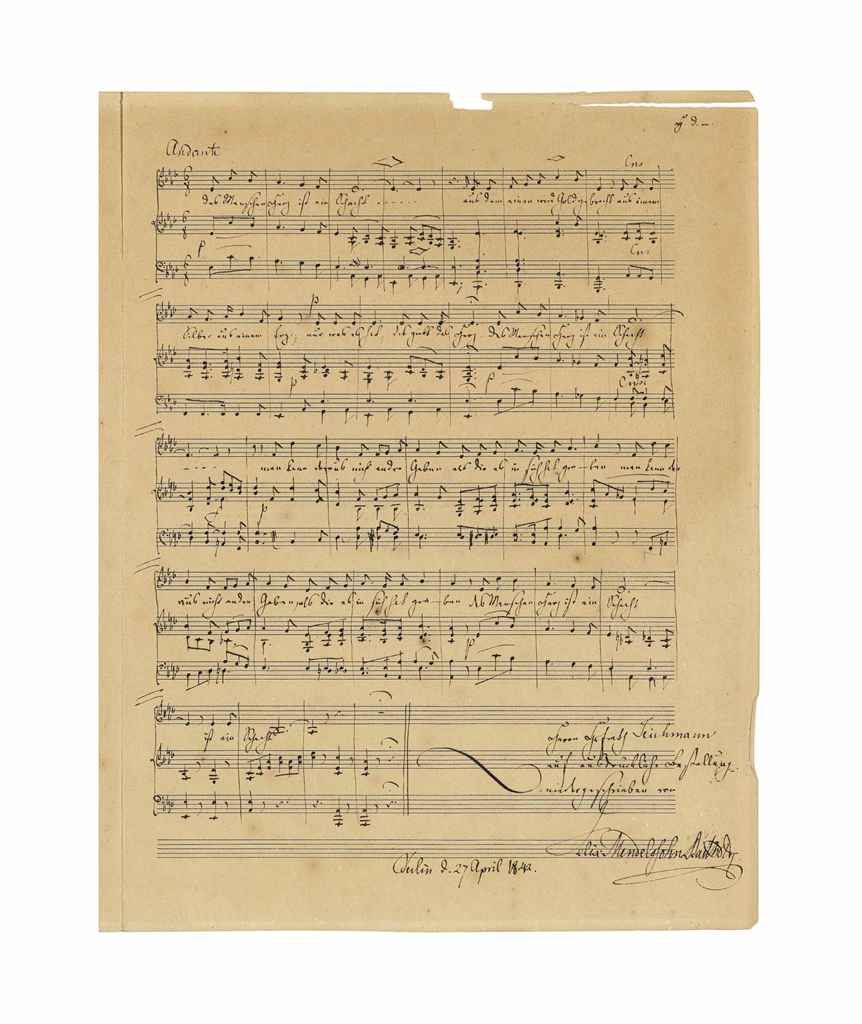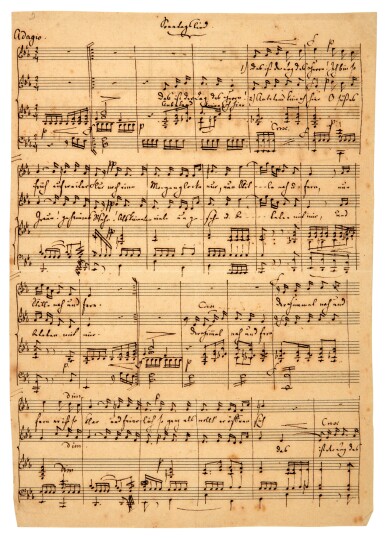Felix Mendelssohn Bartholdy
Autograph manuscript score of Mendelssohn's arrangement for violin and piano of the opening movement of J.S. Bach's Partita no.3 in E major for unaccompanied violin, BWV 1006, BOLDLY SIGNED AND INSCRIBED BY MENDELSSOHN TO THE VIOLINIST FERDINAND DAVID ("An F.David zur und aus der Erinnerung niedergeschrieben FMB...")
a working manuscript, notated in brown/black ink on up to five three-stave systems per page, the violin stave left blank, with some additions, dynamic marks and corrections in pencil and blue crayon
4 pages, folio (30 x 23cm), Leipzig, 11 November 1846, overall browning, some staining, two small old repairs, one affecting one word, a few tiny stains, some small tears to outer margins, otherwise in good condition
Before its discovery by Sotheby’s, this arrangement was unknown, undocumented and unpublished. It provides another link in the reception history of Bach’s music in the nineteenth century and also shows the great interest that Mendelssohn had for his illustrious predecessor in Leipzig. Mendelssohn was, of course, the major figure in the revival of the music of Bach, particularly in the city where both composers spent their mature years. Mendelssohn’s performances of the St. Matthew Passion in 1829, in Berlin, and in 1841 in Leipzig, are both major events in the modern history of Bach’s music.
In adding a keyboard part to the solo violin partita movement, Mendelssohn has, of course, gone much further than in his editorial work on the St. Matthew Passion: the keyboard part is entirely composed by him. Mendelssohn was almost certainly aware of Bach’s orchestral expansion of the partita movement, where it was reworked as the Sinfonias in Cantatas BWV 29 and 120a. Although much of the material is similar, Mendelssohn does not merely make a keyboard transcription of the Sinfonias (which are scored for organ solo and large orchestra and are some twenty bars longer than the violin original), but he freely adapts the material to make it suitable for keyboard and violin. He changes chords, patterns and textures, while retaining some, but by no means all the rhythmic bass patterns of the Sinfonias. In short, the accompaniment is his own composition, using Bach’s material.
Of particular interest are the dynamic markings, probably added by Mendelssohn during rehearsals with Ferdinand David, which give some insight into Mendelssohn the performer. David, the leading German violinist of his day, was based, like Mendelssohn, in Leipzig. He was a pupil of Spohr and the teacher of Joseph Joachim and gave the first performance of Mendelssohn’s great E minor Violin Concerto, which the composer subsequently dedicated to him. Although this manuscript is dated 1846, David and Mendelssohn are recorded as performing the arrangement in Leipzig as early as 8 February 1840 (TNG, xvi, p.418). This probably explains Mendelssohn’s cryptic dedication to David on the manuscript ("...in memory of, and from memory by, the undersigned..."), which seems to suggest that he was writing the music out without the aid of any other score. Mendelssohn’s death in 1847 was a great loss for David, and he was a pallbearer at his funeral. Later, he assisted Mendelssohn’s brother Paul, who, with others, edited many of the unpublished works.
The first modern performance of this arrangement took place under Ralph Kohn’s auspices at Buckingham Palace, London, on 7 December 2000, on the occasion of a dinner in aid of the Bach Cantata Pilgrimage, hosted by the Prince of Wales. The performers were Maya Homburger, violin, who played on an Italian instrument made by Antonio della Costa in 1740 and Howard Moody, piano, who performed on an Erard piano of 1843.
PROVENANCE:Sotheby’s, London, 9 December 1999 (lot 174)
Felix Mendelssohn Bartholdy
Autograph manuscript score of Mendelssohn's arrangement for violin and piano of the opening movement of J.S. Bach's Partita no.3 in E major for unaccompanied violin, BWV 1006, BOLDLY SIGNED AND INSCRIBED BY MENDELSSOHN TO THE VIOLINIST FERDINAND DAVID ("An F.David zur und aus der Erinnerung niedergeschrieben FMB...")
a working manuscript, notated in brown/black ink on up to five three-stave systems per page, the violin stave left blank, with some additions, dynamic marks and corrections in pencil and blue crayon
4 pages, folio (30 x 23cm), Leipzig, 11 November 1846, overall browning, some staining, two small old repairs, one affecting one word, a few tiny stains, some small tears to outer margins, otherwise in good condition
Before its discovery by Sotheby’s, this arrangement was unknown, undocumented and unpublished. It provides another link in the reception history of Bach’s music in the nineteenth century and also shows the great interest that Mendelssohn had for his illustrious predecessor in Leipzig. Mendelssohn was, of course, the major figure in the revival of the music of Bach, particularly in the city where both composers spent their mature years. Mendelssohn’s performances of the St. Matthew Passion in 1829, in Berlin, and in 1841 in Leipzig, are both major events in the modern history of Bach’s music.
In adding a keyboard part to the solo violin partita movement, Mendelssohn has, of course, gone much further than in his editorial work on the St. Matthew Passion: the keyboard part is entirely composed by him. Mendelssohn was almost certainly aware of Bach’s orchestral expansion of the partita movement, where it was reworked as the Sinfonias in Cantatas BWV 29 and 120a. Although much of the material is similar, Mendelssohn does not merely make a keyboard transcription of the Sinfonias (which are scored for organ solo and large orchestra and are some twenty bars longer than the violin original), but he freely adapts the material to make it suitable for keyboard and violin. He changes chords, patterns and textures, while retaining some, but by no means all the rhythmic bass patterns of the Sinfonias. In short, the accompaniment is his own composition, using Bach’s material.
Of particular interest are the dynamic markings, probably added by Mendelssohn during rehearsals with Ferdinand David, which give some insight into Mendelssohn the performer. David, the leading German violinist of his day, was based, like Mendelssohn, in Leipzig. He was a pupil of Spohr and the teacher of Joseph Joachim and gave the first performance of Mendelssohn’s great E minor Violin Concerto, which the composer subsequently dedicated to him. Although this manuscript is dated 1846, David and Mendelssohn are recorded as performing the arrangement in Leipzig as early as 8 February 1840 (TNG, xvi, p.418). This probably explains Mendelssohn’s cryptic dedication to David on the manuscript ("...in memory of, and from memory by, the undersigned..."), which seems to suggest that he was writing the music out without the aid of any other score. Mendelssohn’s death in 1847 was a great loss for David, and he was a pallbearer at his funeral. Later, he assisted Mendelssohn’s brother Paul, who, with others, edited many of the unpublished works.
The first modern performance of this arrangement took place under Ralph Kohn’s auspices at Buckingham Palace, London, on 7 December 2000, on the occasion of a dinner in aid of the Bach Cantata Pilgrimage, hosted by the Prince of Wales. The performers were Maya Homburger, violin, who played on an Italian instrument made by Antonio della Costa in 1740 and Howard Moody, piano, who performed on an Erard piano of 1843.
PROVENANCE:Sotheby’s, London, 9 December 1999 (lot 174)







.jpg)


.jpg)



Try LotSearch and its premium features for 7 days - without any costs!
Be notified automatically about new items in upcoming auctions.
Create an alert